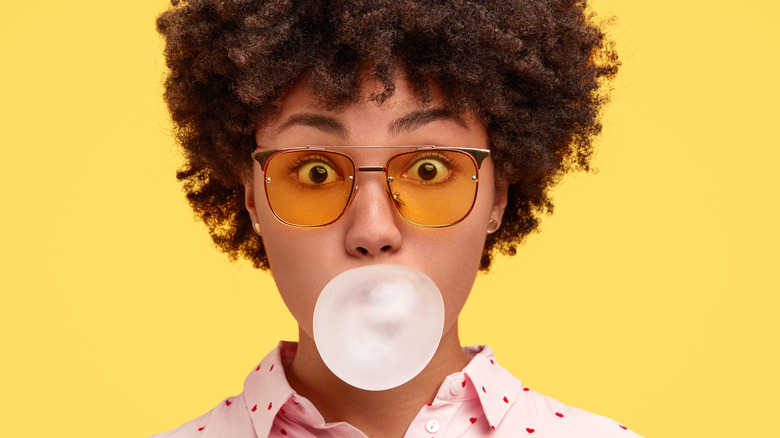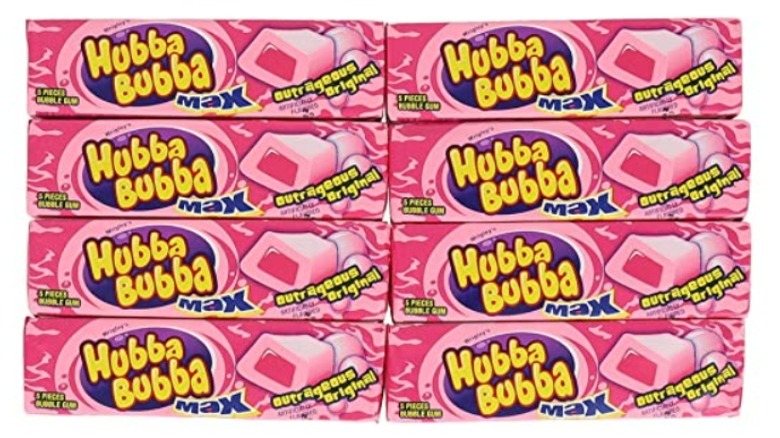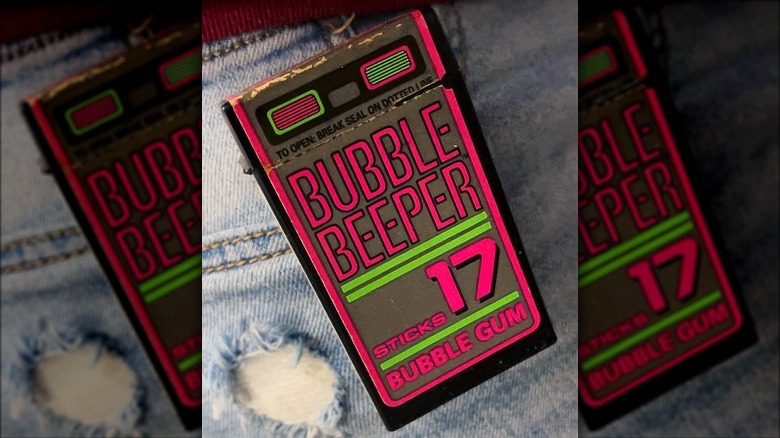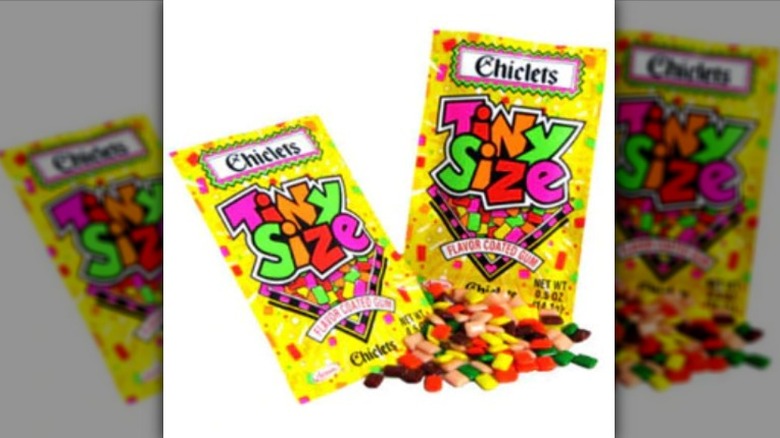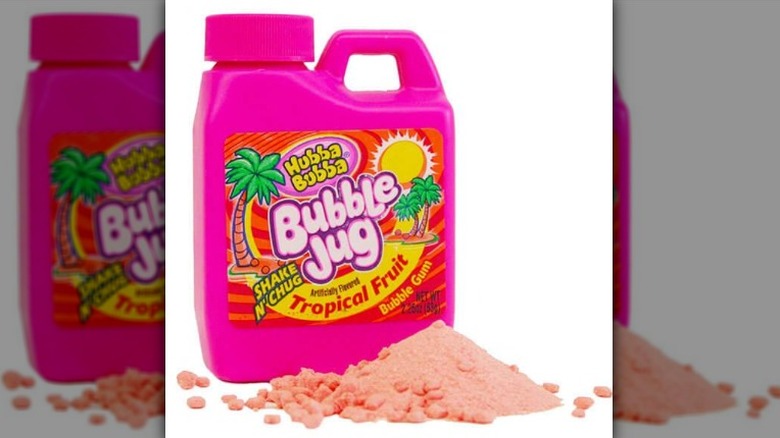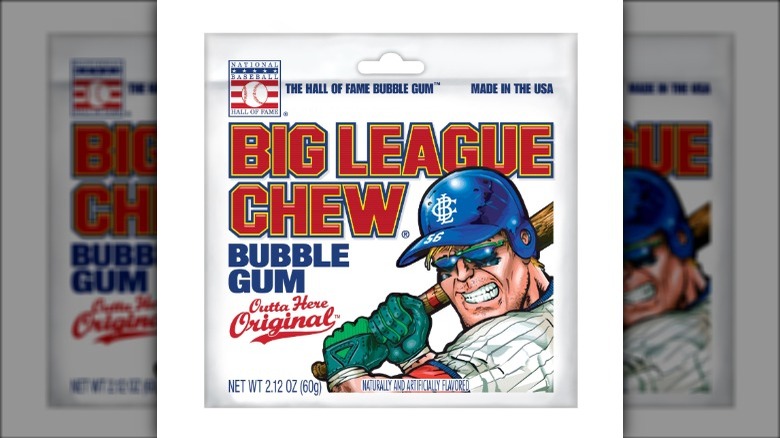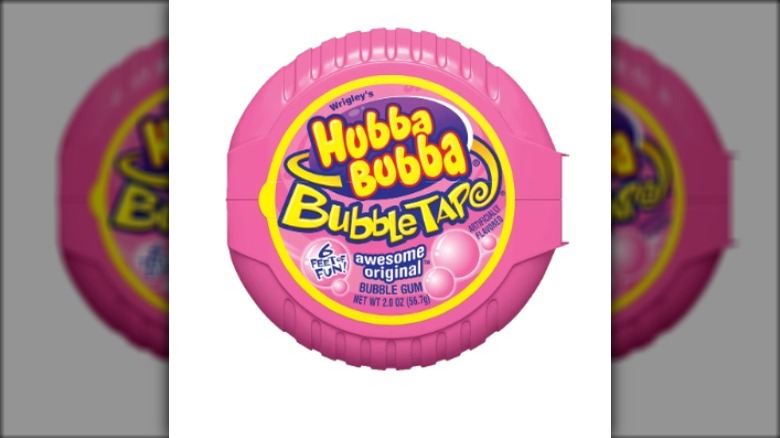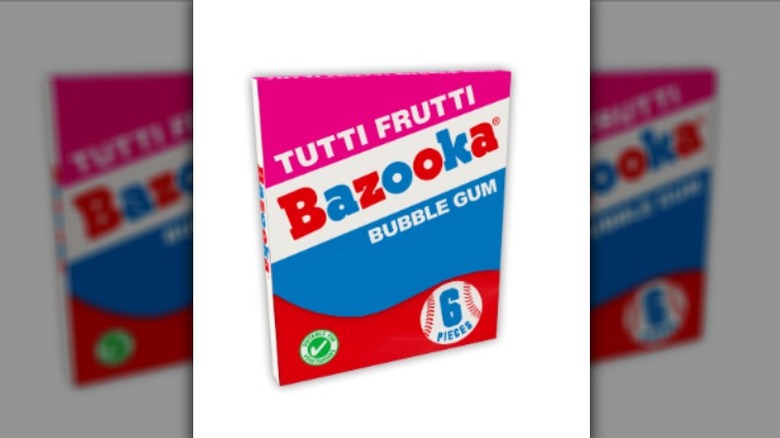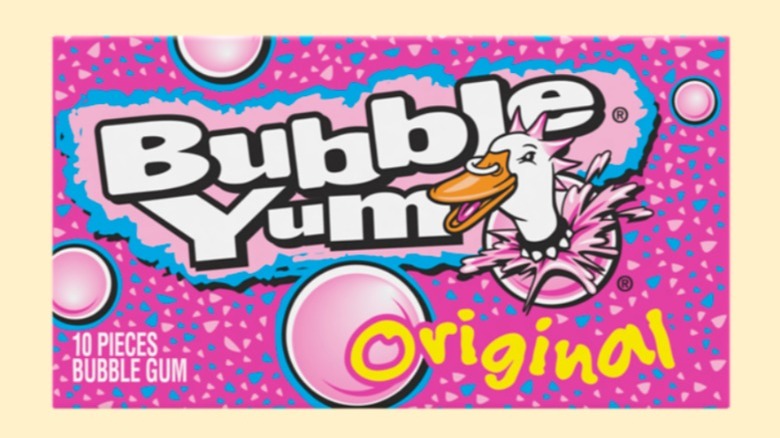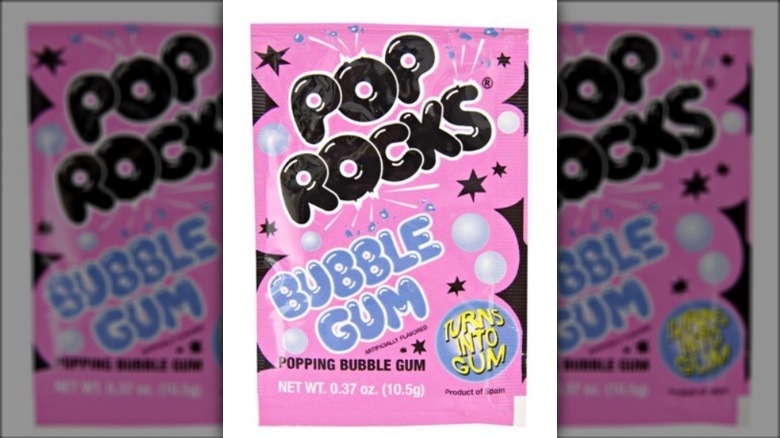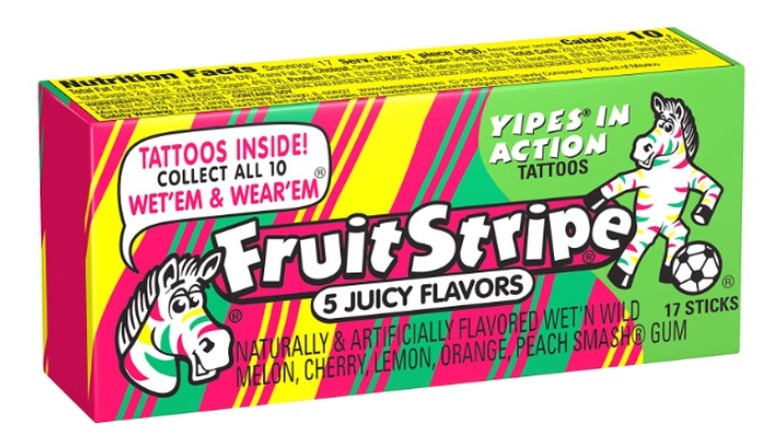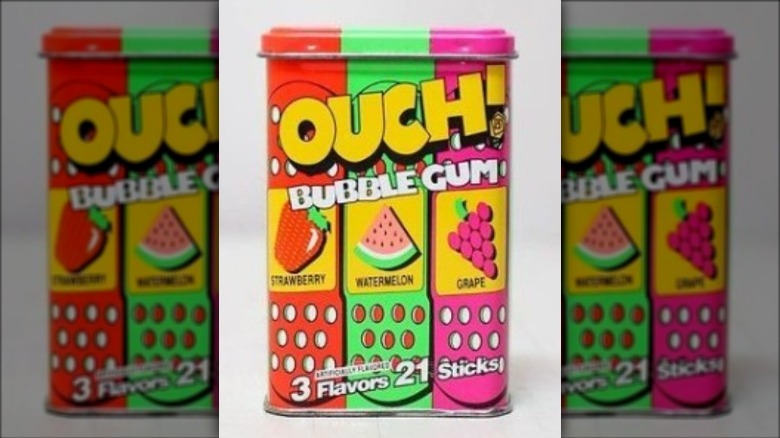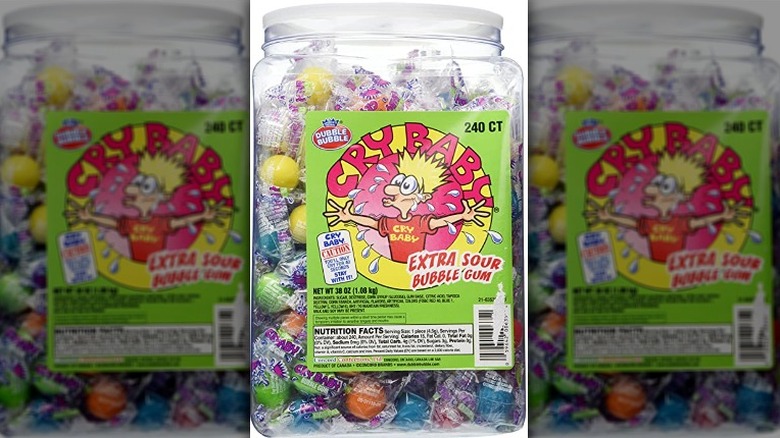90s Bubble Gums That Used To Be Everywhere
We may receive a commission on purchases made from links.
Gum may seem modern, but this candy's roots stretch back to ancient times. According to Smithsonian Magazine, gum lovers can credit the Aztecs and Mayans with creating the concept of chewing gum. Both civilizations discovered that tree bark resin could be transformed into a chewable treat that helped prevent dehydration and curbed one's appetite.
In the U.S., William Wrigley Jr. brought Juicy Fruit and Wrigley's Spearmint gum to life in the late 1890s, creating the foundation of his longstanding gum company. However, the 20th century brought the gum industry into a new era. In 1928, a Fleer accountant named Walter Diemer accidentally created a new candy that would become a worldwide phenomenon: bubble gum, a softer and thicker version of traditional chewing gum with a bright pink hue.
Although almost every decade since has had its own list of popular bubble gums, the 1990s offered some of the most unique varieties. Kids and adults alike fell in love with gums that had unique concepts and never-before-seen flavors. As a result, this decade's most popular bubble gums were a common sight in supermarkets, convenience stores, and candy shops nationwide. Some have since faded into oblivion, but many are still available for a whole new generation of gum chewers to enjoy.
Hubba Bubba Max
Hubba Bubba gave consumers many bubble gum options in the 1990s, but Hubba Bubba Max was among the most recognizable because of its unusual consistency. This candy had a sweet liquid center that added extra juiciness while chewing and often had a different flavor than the surrounding gum. As consumers chewed the gum, the complementary flavors combined to give the gum a whole new taste. In addition, it was packaged in thick blocks instead of sticks, which lent extra softness to the overall texture. Memorable commercials from the '90s (via YouTube) featured a variety of hilarious cartoon animals describing the deliciousness of the flavors, several of which were pleasantly sour.
Although some of the '90s-era flavors aren't available anymore, the original version of this gum is still for sale in many stores nationwide. Furthermore, the strawberry-watermelon variety is still available on Amazon, and the Walmart website carries the original sour blue raspberry flavor. Present-day reviews from Chick Advisor note that this gum is excellent for blowing large bubbles and still has the same great taste as ever. "This gum always reminds me of my childhood!" one reviewer stated. Many also say that the candy's flavor lasts longer than many other bubble gums, likely due to its concentrated center.
Bubble Beeper Gum
Before smartphones, beepers gave consumers a way to be reachable anytime. Although the devices were actually created decades earlier, the advent of wide-area paging led to a popularity explosion in the 1990s. Unsurprisingly, the Bubble Beeper, a bubble gum package designed to look like the real thing, took off in a big way with '90s kids who wanted to emulate their parents. The colorful plastic package could be clipped onto a belt loop or pants pocket and was roughly the size of an actual pager. The gum inside even had wrappers that displayed fun beeper-inspired messages such as "Urgent!" and "See You Later."
However, this seemingly innocent candy caused some controversy soon after its release. A 1992 article in The Morning Call newspaper in Pennsylvania explains that some parents associated pagers with drug dealers, which made them reluctant to buy this product for their children. Furthermore, the article notes that even a known drug dealer in Philadelphia thought the gum's gimmick was potentially dangerous for children in some neighborhoods. Despite this controversy, the Bubble Beeper remained popular throughout the decade. Unfortunately, it suffered the same fate as its real-life counterpart and fell out of favor as cell phones became the norm.
Chiclets Tiny Size
The square-shaped, multicolored chewing gum Chiclets first appeared in the early 1900s, but its history is murky. Some sources, such as the Los Angeles Times, credit Louis W. Mahle with creating this product, while others, including ThoughtCo., claim that Thomas Adams is the gum's true inventor. Regardless of these conflicting accounts, one thing is clear: The gum gets its name from its main ingredient, chicle, a natural substance found in sapodilla trees. Chicle was a common ingredient in chewing gum for centuries and likely arrived in the U.S. in the 1850s.
Although Chiclets wasn't a new product in the 1990s, its colorful miniature counterpart, Chiclets Tiny Size, was still undeniably popular. This twist on the classic premiered in 1962 and came in a brightly colored package that stood out on candy shelves. This gum variety isn't known for producing giant bubbles, but it was still fun to chew. For example, many Reddit users recall pouring the whole bag into their mouth at once to make a massive piece of gum. Unfortunately, this exact product is no longer as easy to find as it once was. Still, websites like Amazon offer plenty of alternatives, including a three-pound bag of Mini Chiclets that look very similar to the original.
Bubble Jug
The 1990s was undoubtedly a heyday for unusual candy concepts, including the pourable powdered bubble gum in Hubba Bubba Bubble Jug. This since-discontinued product was yet another member of the Hubba Bubba brand of gums and was available in multiple fruit-based flavors. Consumers could easily decide how much bubble gum they wanted by pouring out their desired amount of powder and chewing until it formed a cohesive piece of gum. Despite being discontinued for years, this gum still has some loyal fans. For example, one devotee started a petition on Change.org to get this product back on shelves, and many petition signers reported loving this gum during the 1990s.
However, those who want to experience this tasty candy again have an alternative: Kidsmania currently offers its own version of powdered gum both in stores and online. Its Sour Sneaky Stardust Bubble Gum has three flavors and jug-shaped packaging like the '90s original. A TikTok review demonstrates the bubble-blowing possibilities of this product, which looks precisely like Bubble Jug when poured out of its packaging. Ultimately, Sneaky Stardust is likely a good alternative for anyone who truly misses this fun take on traditional bubble gum, although the sour flavors differ from the original Bubble Jug.
Big League Chew
Baseball and bubble gum have been closely associated for decades, starting when William Wrigley Jr. named his newly purchased Chicago baseball team's stadium after his family's gum business in 1927 . Wrigley Field has retained its iconic moniker for nearly a century, and it seems the name is here for good. As NBCSports explains, bubble gum became a popular choice for baseball players in the 1980s as a healthier alternative to chewing tobacco. Even today, bubble gum is a common sight in bullpens for many MLB teams.
In 1977, a Portland Mavericks player came up with the idea for a product that perfectly combines America's pastime and the classic candy: Big League Chew. The gum hit shelves in 1980 and has been popular with both players and fans ever since. Instead of traditional sticks, Big League Chew comes in shredded pieces packaged together in a pouch. Throughout its history, the gum and its connection to baseball have remained constant. According to SBNation, the gum even featured a handful of Baseball Hall Of Fame players on packages from the 1990s, which many gum-chewers may remember fondly. Today, the brand website boasts five flavors with catchy baseball-themed names like Outta Here Original and Big Rally Blue Raspberry that consumers can still find in stores around the country.
Hubba Bubba Bubble Tape
Some candies aren't just delicious — they're also fun to eat. When snappy commercials for Bubble Tape first hit the airways, gum chewers were introduced to a new way to enjoy their favorite candy. Instead of being limited to traditional sticks of gum, Bubble Tape offered consumers the ability to customize the length of each piece. Targeted marketing campaigns made this product especially popular with young teens in the 1990s. The original package boasted six feet of gum and quickly spawned additional flavors.
Even now, Bubble Tape is alive and well; consumers can still purchase it from multiple online retailers, and some brick-and-mortar stores stock it as well. Many Influenster reviews praise this gum for its texture and flavor, so it's clear that the Bubble Tape of today is as delicious as ever. According to The Spectator, Hubba Bubba at one point sold a nine-foot King Size and a 10-foot Mega Roll of Bubble Tape. Like many popular products from yesteryear, Bubble Tape has now amassed a following among collectors. For example, '90s-era Bubble Tape containers are a popular sight on eBay, where fans can find many of the brand's most popular flavors.
Bazooka Bubble Gum
Although Bazooka Bubble Gum was very popular with '90s gum chewers, this classic candy's story started long before that. According to Candy Favorites, its origins date back to the post-World War II era in 1947. The gum had red, white, and blue packaging to reflect the patriotic sentiments of the time. Bazooka is the quintessential bubble gum: bright pink with a thick, soft texture and slightly fruity flavor. However, one of this gum's most recognizable features is its mascot, Bazooka Joe, who first came to life in the 1950s and helped market the gum.
This lovable character starred in a comic strip series printed on Bazooka gum wrappers, and those comic strips quickly became collectible items. As Bubble Gum Comics explains, the comic strip was updated in 1989 and again in 1996, meaning '90s consumers enjoyed a new look and feel for Bazooka Joe. Although comic strip gum wrappers have become a thing of the past, many fans are still passionate about Bazooka Joe and his eclectic group of friends. In 2013, the Bazooka Bubble Gum distributor Topps even released a hardcover book commemorating the character. "Bazooka Joe and His Gang" contains over 100 comic strip reprints, representing just a fraction of the thousands released across the gum's 50-plus-year history.
Bubble Yum Bubble Gum
In the 1990s, an independent-thinking bird named Floyd D. Duck began starring in Bubble Yum Bubble Gum commercials. Floyd's studded collar and spiky pink "hair" instantly made him memorable and helped Bubble Yum stand out from the crowd of this decade's gimmicky candies. Although Floyd was new to the world of bubble gum, Bubble Yum debuted in the early 1970s. This gum featured the traditional bright, slightly fruity flavor consumers expect from bubble gum, but its surprisingly soft texture made it more pleasant to chew than many other leading brands.
Modern consumers can still find Bubble Yum in many stores that sell candy. The gum is available in two primary flavors (original and Cotton Candy), although limited-time varieties occasionally hit the market. Overall, internet reviews suggest that the gum's quality is comparable to what consumers remember from the '90s. Hershey has owned the brand since 2000, and reviews on the company's website are mostly positive. Unsurprisingly, many people love the memories that chewing this gum brings back, with some reporting that the flavor is as delicious as ever. Most Influenster reviewers also love the taste, though some wish it would last longer.
Pop Rocks Gum
Pop Rocks are little sugary crystals that pack a surprisingly fizzy punch, and kids of all ages have enjoyed them for decades. Chemist William Mitchell inadvertently invented this unique treat while attempting to create instant soda, and it officially hit shelves in 1975. Although an urban legend made these curious candies seem dangerous enough to be discontinued in the 1980s (via Snopes), Pop Rocks have enjoyed enduring popularity since this short-lived hiatus. The unique eating experience this candy provides set it apart from the competition and has kept the brand alive to this day.
Finally, in the 1990s, consumers got to experience this effervescent treat in a whole new way with Pop Rocks Bubble Gum. This gum starts in small pellet form like traditional Pop Rocks but gradually transforms into gum when chewed. Like its predecessor candy, many retailers still offer this gum for modern-day shoppers. Unfortunately, as several Influenster reviewers note, the softness of the gum detracts from the signature popping sensation consumers love about the original candy. However, many reviewers agree that the classic bubble gum flavor is pleasant and long-lasting.
Fruit Stripe Gum
Mascots can go a long way in making a product popular with kids, and Yipes the Zebra has helped Fruit Stripe Gum attract young consumers for over 50 years. This gum was recognizable for its colorful striped print and came in five flavors. Each flavor had its own color, making it easy for consumers to identify their favorites. Although gum lovers can thank the 1960s for this unique confection, kids in the 1990s fell in love with it all over again for its fruity flavor and the temporary tattoos in each package. The combination was marketing gold during this period and kept the gum popular for years.
However, as a Reddit thread points out, this gum's gimmick was far more successful than its flavor. The original poster calls Fruit Stripe Gum "the most flavorful 30 seconds of your life, plus tattoos!" Many users in the thread agree, although some admit that the short-lived taste was still delightful. Luckily for anyone still looking for a Fruit Stripe fix today, this gum is still available for purchase and still features Yipes-themed tattoos that let consumers display their 1990s nostalgia with pride.
Ouch! Bubble Gum
Bandages may not be the first thing most people associate with gum, but Ouch! Bubble Gum made that combination into a fun, fruity confection that '90s consumers loved. It originally came in three classic flavors: strawberry, watermelon, and grape. The gum came in wrappers resembling neon bandages, and it was initially sold in highly collectible metal tins with a generous amount of stickers included. In the following decade, the gum was rebranded under Hubba Bubba, and the packaging changed from metal tins to a more standard paper-based container.
Unfortunately, this effort to revamp the classic gum didn't succeed, and it has since been discontinued. Although this gum has disappeared from shelves, its original tins live on as beloved relics of '90s pop culture history. For example, sites like eBay feature scores of listings for these tins, with many selling for far more than a pack of Ouch! Bubble Gum ever cost (as much as $40 or more in some cases). Reddit also features multiple nostalgia-themed threads dedicated to this gum, with most users remembering it more for its fun concept than its flavor.
Cry Baby Extra Sour Gum
Like Warheads, Cry Baby Extra Sour Gum appealed to 1990s candy consumers' love of all things extreme when it came to their favorite sugary treats. This product first appeared in stores in 1991, making it a true '90s original. As the packaging indicates, these gumballs were made from Dubble Bubble gum, which has been around for nearly a century. The gumballs came in multiple flavors, but they all had one thing in common: an intensely sour exterior. Luckily for those with a low tolerance for sourness, the coating quickly faded, leaving behind a pleasantly sweet, long-lasting gum.
This bubble gum variety is still alive and well today and comes in six fruity varieties, including orange, cherry, and watermelon. Many candy fans see sour flavors as a fun challenge, and these gumballs are perfect for testing one's tolerance for acidity. Furthermore, its parent company, Tootsie Roll Industries, now offers multiple ultra-sour products besides the classic gum. For example, Cry Baby Sour Chews offer the gum's same satisfying tartness as chewy candy. Several Reddit users have created threads recommending these, especially those who enjoy sampling a piece of '90s candy history.
